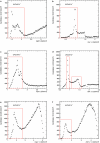Observation of charge-parity symmetry breaking in baryon decays
- PMID: 40670796
- PMCID: PMC12310544
- DOI: 10.1038/s41586-025-09119-3
Observation of charge-parity symmetry breaking in baryon decays
Abstract
The Standard Model of particle physics-the theory of particles and interactions at the smallest scale-predicts that matter and antimatter interact differently due to violation of the combined symmetry of charge conjugation (C) and parity (P). Charge conjugation transforms particles into their antimatter particles, whereas the parity transformation inverts spatial coordinates. This prediction applies to both mesons, which consist of a quark and an antiquark, and baryons, which are composed of three quarks. However, despite having been discovered in various meson decays, CP violation has yet to be observed in baryons, the type of matter that makes up the observable Universe. Here we report a study of the decay of the beauty baryon to the pK-π+π- final state, which proceeds through b → u or b → s quark-level transitions, and its CP-conjugated process, using data collected by the Large Hadron Collider beauty experiment1 at the European Organization for Nuclear Research (CERN). The results reveal significant asymmetries between the decay rates of the baryon and its CP-conjugated antibaryon, providing, to our knowledge, the first observation of CP violation in baryon decays and demonstrating the different behaviours of baryons and antibaryons. In the Standard Model, CP violation arises from the Cabibbo-Kobayashi-Maskawa mechanism2, and new forces or particles beyond the Standard Model could provide further contributions. This discovery opens a new path in the search for physics beyond the Standard Model.
© 2025. The Author(s).
Conflict of interest statement
Competing interests: The authors declare no competing interests.
Figures






References
-
- LHCb Collaboration. The LHCb detector at the LHC. J. Instrum.3, S08005 (2008).
-
- Kobayashi, M. & Maskawa, T. CP-violation in the renormalizable theory of weak interaction. Prog. Theor. Phys.49, 652 (1973).
-
- Dirac, P. A. M. The quantum theory of the electron. Proc. R. Soc. A117, 610 (1928).
-
- Anderson, C. D. The positive electron. Phys. Rev.43, 491 (1933).
-
- Chamberlain, O., Segrè, E., Wiegand, C. & Ypsilantis, T. Observation of antiprotons. Phys. Rev.100, 947 (1955).
LinkOut - more resources
Full Text Sources
Research Materials
Miscellaneous

